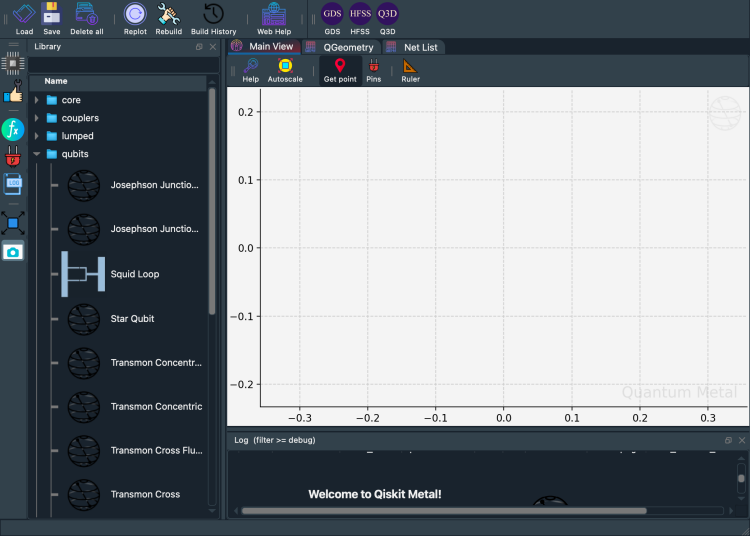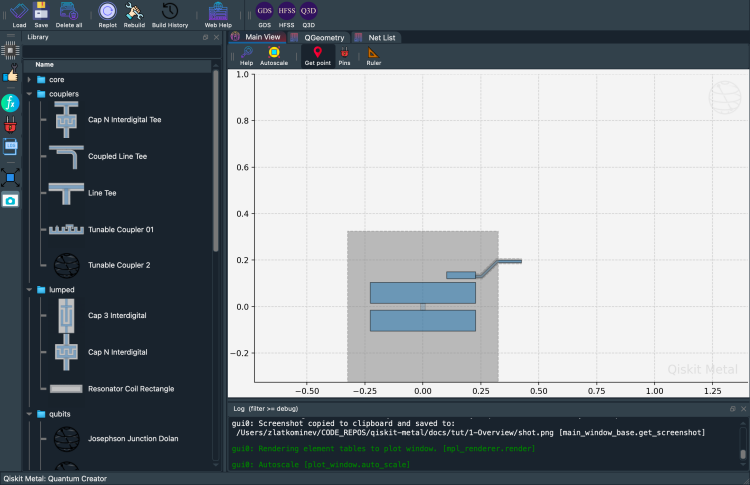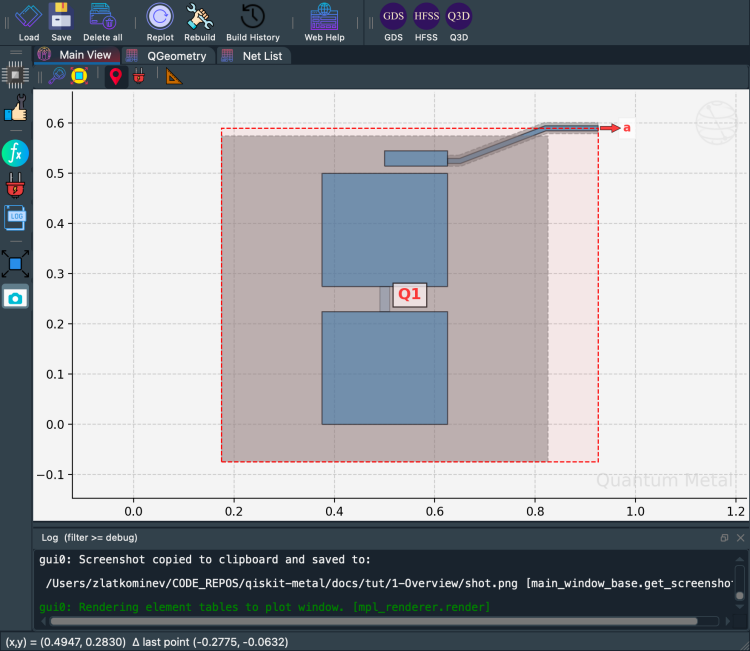Note
This page was generated from tut/1-Overview/1.1-Bird’s-eye-view-of-Qiskit-Metal.ipynb.
Bird’s eye view of Qiskit Metal¶
🌟 The Qiskit Metal Design Flow — Your 4-Step Adventure 🌟¶
Let’s walk through the four stages you’ll use again and again:
1. Pick a Design Class 🏗️¶
2. Add & Customize Components 🎨¶
Prefer to build from scratch? You can always 👉 create your own custom component, see the Tutorial in Chapter “2 From components to chip/D. How do I make my custom QComponent/2.31 Create a QComponent - Basic.ipynb”.
3. Render → Simulate → Analyze 🔍¶
Once your design looks good, it’s time to explore how it behaves.
Current Rendering & Simulation Options:
Ansys Integration
HFSS Renderer — for high-frequency simulations (eigenmode, modal, terminal)
EPR Analysis → computes energy participation ratios
Q3D Renderer — extracts layout-based equivalent circuit parameters (e.g., capacitances)
LOM Analysis → uses Q3D capacitances to evaluate transmon parameters
This is the “science happens here” step. 🔬✨
4. Render for Fabrication 🏭¶
When you’re ready to turn your design into something real:
GDS Renderer Output clean, fabrication-ready GDSII files that you can send to your foundry.
🎯 Visual Summary¶
All of these steps come together in the diagram below — showing how designs flow from concept → components → simulation → fabrication.
This tutorial focuses on Steps 1 and 2 — creating a design and adding components.
Using This Tutorial 🚀¶
You can work with Qiskit Metal in three different ways. Each has its own vibe:
1. Jupyter Notebooks 📓 (perfect for learning & experimenting)¶
Great for interactive exploration
Fast feedback loop
To use:
Hit Run and enjoy the magic 😄
2. Python Scripts 🧪 (perfect for debugging & automation)¶
Ideal when you want breakpoints or repeatable workflows
To use:
Copy snippets from these notebooks into a
.pyfileRun it in your favorite editor (we love VS Code!)
3. Metal GUI 🖥️ (visual editing)¶
The GUI continues to evolve and will eventually support the full workflow
To use:
First create your design in a notebook or script (the GUI won’t create components for you yet)
Then open the GUI to visualize and manually adjust your design
Let’s dive in! 🌊
QDesign — What You Need to Know ⭐️¶
Every quantum circuit you build in Qiskit Metal begins by instantiating a ``QDesign`` subclass.
The design library
qiskit_metal.designscontains several design classes tailored for different geometries.Example:
DesignPlanar→ ideal for 2D chip layouts
All design classes inherit from the base
QDesignclass.QDesigndefines core behavior and should not be instantiated directly.
QDesign — A Closer Look 🔍¶
QDesign is the “brain” of your quantum chip model. It keeps track of:
All components you add (qubits, resonators, coplanar waveguides, etc.)
Their parameters and geometry
Their relationships (connections, nets, etc.)
Metadata and simulation settings
QDesign organizes and manages all the moving parts in your circuit.Key Concepts in the QDesign Universe ✨¶
To understand how Qiskit Metal organizes your circuit, here are the main “building blocks” working behind the scenes.
QComponents 🧱¶
These represent the physical pieces of your design — but you never instantiate them directly.
Examples include:
Transmon qubits
Coplanar waveguides (CPWs)
Resonators, pads, and more
When you add a component to your design:
The component’s
make()method runsIt creates the underlying geometry (rectangles, traces, arcs, etc.)
These shapes are added to the design’s
QGeometryTables
Think of QComponents as templates that generate real geometry when placed into your design.
QGeometryTables 📐¶
Created automatically when your QDesign initializes.
They store:
Backend-ready geometric data
The shapes produced by each QComponent (polygons, paths, pins, etc.)
As you add components, these tables fill up with the geometry that eventually gets rendered or simulated.
QNet.net_info 🔗¶
Also created during QDesign initialization.
This stores:
All connections between your components
Pin-to-pin relationships, signal paths, and logical nets
Whenever you connect components (e.g., qubit → resonator → feedline), the net_info structure is updated automatically.
QRenderer 🖨️¶
Initialized inside the design as well.
Renderers are what let you export your design to tools like:
Ansys HFSS
Ansys Q3D
GDSII for fabrication
The file qiskit_metal/config.py lists all renderers detected and ready to use.
🎉 Coding Time!¶
QComponent.Run the cell below:
[13]:
%load_ext autoreload
%autoreload 2
from qiskit_metal import designs
The autoreload extension is already loaded. To reload it, use:
%reload_ext autoreload
Import Qiskit Metal¶
[14]:
from qiskit_metal import designs # Library of chip designs
%metal_heading Welcome to Qiskit Metal!
Welcome to Qiskit Metal!
My First Quantum Design (QDesign) ✨¶
Time to make something real! Every Qiskit Metal project begins by choosing a design layout — this determines how your components will be arranged on the chip.
We’ll start with the simplest option:
[15]:
design = designs.DesignPlanar()
[16]:
# Since we are likely to be making many changes while tuning and modifying our design, we will enable overwriting.
# If you disable the next line, then you will need to delete a component [<component>.delete()] before recreating it.
design.overwrite_enabled = True
[17]:
%metal_heading Hello Quantum World!
Hello Quantum World!
Inspecting Your Chip 🧱¶
Every design starts with a default chip called "main". Let’s peek at its properties — size, material, thickness, and other fabrication-related details.
[18]:
# We can also check all of the chip properties to see if we want to change the size or any other parameter.
# By default the name of chip is "main".
design.chips.main
[18]:
{'material': 'silicon',
'layer_start': '0',
'layer_end': '2048',
'size': {'center_x': '0.0mm',
'center_y': '0.0mm',
'center_z': '0.0mm',
'size_x': '9mm',
'size_y': '6mm',
'size_z': '-750um',
'sample_holder_top': '890um',
'sample_holder_bottom': '1650um'}}
You’ll see a dictionary describing everything about the chip’s geometry.
If you want to change its dimensions, just update the values:
design.chips.main.size.size_x = '11mm'
design.chips.main.size.size_y = '9mm'
Chip updated! 🛠️
[19]:
design.chips.main.size.size_x = '11mm'
design.chips.main.size.size_y = '9mm'
Launch Qiskit Metal GUI to interactively view, edit, and simulate QDesign: Metal GUI
[20]:
from qiskit_metal import MetalGUI
gui = MetalGUI(design)
[10]:
gui.screenshot()

My First Quantum Component (QComponent)¶
Ready to draw your first piece of quantum hardware? A QComponent is a single, reusable building block in Quantum Metal. It knows its own geometry, options, and pins, and it registers itself with the design’s tables so renderers can export it.
Here’s the mental model:
Design owns everything. Components live inside a
Designand share variables and chip bounds.Components declare pins. Pins are named connection points that routes or couplers can attach to.
Options are the API. Every component ships with defaults you can override (dimensions, gaps, orientation, etc.).
Build step writes geometry. When you call
make()(explicitly or implicitly), the component populates the QGeometry tables.
We’ll start with a planar design and drop a simple component into it. This notebook uses short, readable code so you can reuse it as a template in your own projects.
What you’ll do next:
Create a
DesignPlanarcontainer.Instantiate a QComponent with custom options.
Inspect its pins and geometry tables.
Render or export to verify everything looks right.
[ ]:
# Select a QComponent to create (The QComponent is a python class named `TransmonPocket`)
from qiskit_metal.qlibrary.qubits.transmon_pocket import TransmonPocket
q1 = TransmonPocket(design, 'Q1', options=dict(connection_pads=dict(a=dict()))) # Create a new Transmon Pocket object with name 'Q1'
gui.rebuild() # rebuild the design and plot
gui.edit_component('Q1') # set Q1 as the editable component
gui.autoscale() # resize GUI view to see QComponent
[11]:
gui.screenshot()

Let’s see what the Q1 object looks like
[21]:
print(q1) #print Q1 information
name: Q1
class: TransmonPocket
options:
'pos_x' : '0.0um',
'pos_y' : '0.0um',
'orientation' : '0.0',
'chip' : 'main',
'layer' : '1',
'connection_pads' : {
'a' : {
'pad_gap' : '15um',
'pad_width' : '125um',
'pad_height' : '30um',
'pad_cpw_shift' : '5um',
'pad_cpw_extent' : '25um',
'cpw_width' : 'cpw_width',
'cpw_gap' : 'cpw_gap',
'cpw_extend' : '100um',
'pocket_extent' : '5um',
'pocket_rise' : '65um',
'loc_W' : '+1',
'loc_H' : '+1',
},
},
'pad_gap' : '30um',
'inductor_width' : '20um',
'pad_width' : '455um',
'pad_height' : '90um',
'pocket_width' : '650um',
'pocket_height' : '650um',
'hfss_wire_bonds' : False,
'q3d_wire_bonds' : False,
'aedt_q3d_wire_bonds': False,
'aedt_hfss_wire_bonds': False,
'hfss_inductance' : '10nH',
'hfss_capacitance' : 0,
'hfss_resistance' : 0,
'hfss_mesh_kw_jj' : 7e-06,
'q3d_inductance' : '10nH',
'q3d_capacitance' : 0,
'q3d_resistance' : 0,
'q3d_mesh_kw_jj' : 7e-06,
'gds_cell_name' : 'my_other_junction',
'aedt_q3d_inductance': 1e-08,
'aedt_q3d_capacitance': 0,
'aedt_hfss_inductance': 1e-08,
'aedt_hfss_capacitance': 0,
module: qiskit_metal.qlibrary.qubits.transmon_pocket
id: 1
What are the default options?
The QComponent comes with some default options like the length of the pads for our transmon pocket.
Options are parsed internally by Qiskit Metal via the component’s
makefunction.You can change option parameters from the gui or the script api.
[22]:
%metal_print How do I edit options? API or GUI
You can now use the Metal GUI to edit, plot, and modify quantum components. Equivalently, you can also do everything from the Jupyter Notebooks/Python scripts (which call the Python API directly). The GUI is just calling the Python API for you.
We’ll nudge the qubit’s position and reshape its pads by overriding a few options:
pos_x,pos_y: move the component on the chip (strings with units are fine).pad_height,pad_width: size of each pad.pad_gap: clearance between the pad and pocket.
You must use a string when setting options!
[23]:
# Change options
q1.options.pos_x = '0.5 mm'
q1.options.pos_y = '0.25 mm'
q1.options.pad_height = '225 um'
q1.options.pad_width = '250 um'
q1.options.pad_gap = '50 um'
After changing options, rebuild to regenerate the geometry and update the tables:
[ ]:
gui.rebuild() # Update the component geometry, since we changed the options
# Get a list of all the qcomponents in QDesign and then zoom on them.
all_component_names = design.components.keys()
gui.zoom_on_components(all_component_names)
# An alternate way to view within GUI. If want to try it, remove the "#" from the beginning of line.
gui.highlight_components(['Q1']) # set Q1 as the highlighted component
gui.screenshot()

This sequence moves and resizes the qubit, rebuilds its geometry, centers the view on all components, and lets you inspect it interactively in the GUI.
Closing the Qiskit Metal GUI
[15]:
# gui.main_window.close()
🎯 Wrapping up¶
You just walked the essential loop:
Created a planar design and saw how it owns chips, variables, and renderers.
Dropped your first QComponent, inspected its pins/options, and tweaked its geometry.
Used the GUI to rebuild, autoscale, and visually verify changes.
Where to go next?
Add another qubit or a readout resonator and connect pins with a route.
Experiment with renderer exports (GDS, Ansys, MPL) to see how the geometry flows downstream.
Browse other tutorials for analysis workflows (EPR/BBQ) and multi-component layouts.
You’re set to explore—keep iterating, and remember: rebuild after edits, and autoscale to check your work. 🚀
For more information, review the Introduction to Quantum Computing and Quantum Hardware lectures below
|
Lecture Video | Lecture Notes | Lab |
|
Lecture Video | Lecture Notes | Lab |
|
Lecture Video | Lecture Notes | Lab |
|
Lecture Video | Lecture Notes | Lab |
|
Lecture Video | Lecture Notes | Lab |
|
Lecture Video | Lecture Notes | Lab |